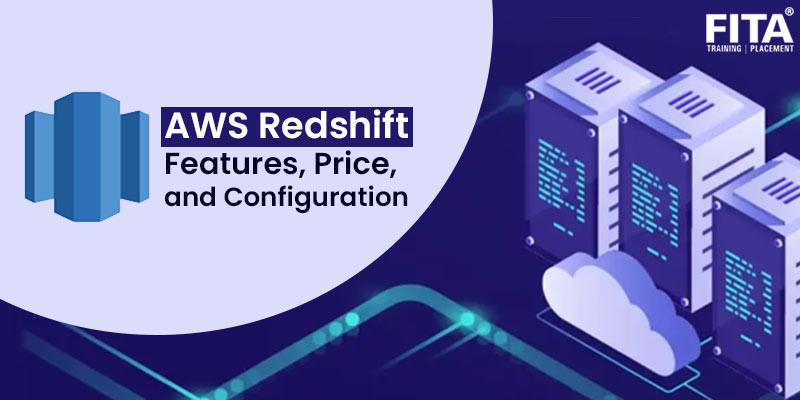
In today’s data-driven world, businesses are constantly dealing with vast amounts of information. Analyzing and extracting valuable insights from this data is crucial for making informed decisions. AWS Redshift, a fully managed data warehousing service, offers a scalable and efficient solution for processing large volumes of data. In this blog , we will explore what AWS Redshift is, its benefits, cost considerations, and a step-by-step guide for setting it up.
What is AWS Redshift?
AWS Redshift is a highly sophisticated and fully managed data warehouse service offered by Amazon Web Services (AWS). As stated by Amazon, it provides an ideal solution for organizations and businesses grappling with the challenges of handling massive amounts of data, often reaching the scale of petabytes. By leveraging the power of the cloud, AWS Redshift enables efficient data analysis, storage, and seamless migration of large-scale databases.
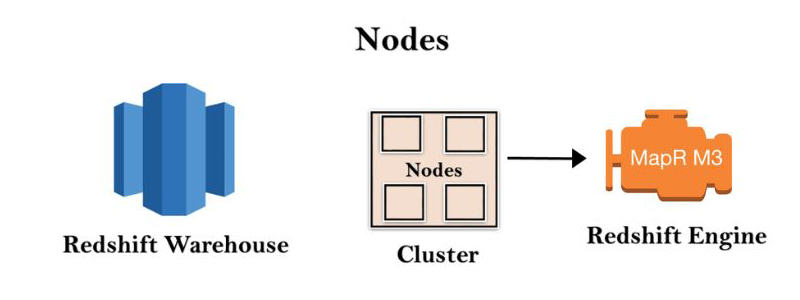
At its core, Redshift utilizes massively parallel processing (MPP) technology, allowing it to process extensive data volumes with remarkable speed while maintaining cost-effectiveness. Each Redshift data warehouse comprises a cluster composed of multiple nodes, each running the Redshift engine and supporting at least one database. This unique architecture empowers users to not only perform advanced analytics but also run traditional relational databases within the AWS ecosystem.
One notable advantage of Redshift lies in its column-oriented database design, which optimizes data storage and retrieval. By organizing data in a columnar format, Redshift significantly enhances read and write performance, making it an excellent choice for analytical workloads. Moreover, being a fully managed service, Redshift offers users the flexibility to start with small data volumes and seamlessly scale up to handle petabytes of data, all while relieving them of the burdens associated with infrastructure management.
With its online analytical processing (OLAP) capabilities, Redshift serves as a robust foundation for businesses seeking to unlock insights from their vast datasets. Its ability to handle complex queries and perform near real-time analysis enables data-driven decision-making and empowers organizations to derive actionable intelligence from their data. Whether it’s processing massive volumes of new data daily or migrating existing databases to the cloud, AWS Redshift stands out as a reliable, scalable, and efficient solution for today’s data-intensive world.
Enrol for AWS Training in Chennai and learn about different service models and deployment models, and methods
AWS Redshift vs. Traditional Data Warehouses
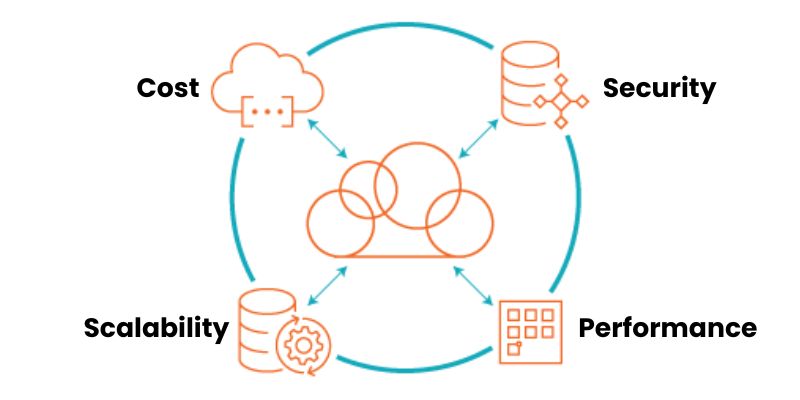
Cost
Traditional data warehouses often come with high upfront costs for hardware and dedicated personnel, along with ongoing maintenance expenses. In contrast, AWS Redshift offers a cost-effective alternative. As a fully managed service, Redshift eliminates the need for significant upfront investments and reduces maintenance costs, providing an accessible solution for businesses of all sizes.
Performance
Redshift outshines traditional data warehouses in terms of performance. It’s massively parallel processing (MPP) technology and columnar data storage architecture enable lightning-fast data processing and query execution. This translates into quicker insights and analysis, empowering users to derive value from their data more efficiently. By undertaking a Data Analytics Training in Chennai, you can gain the skills needed to explore the full potential of Redshift, ultimately enabling you to achieve even greater efficiency in data processing and analysis.
Scalability
Unlike traditional on-premise data warehouses that require additional hardware to scale up, Redshift offers instant and cost-effective scalability. With Redshift, customers can easily adjust their resources to match processing and storage demands without the need for significant infrastructure investments. Additionally, the on-demand pricing structure allows users to pay only for the resources they consume, ensuring cost efficiency and flexibility.
Security
Security is a paramount concern when it comes to data storage. While some organizations may feel more secure with their data stored on-premises, it’s important to note that AWS Redshift adheres to rigorous security best practices. The cloud environment of Redshift provides robust security measures and ongoing compliance efforts. It’s essential to understand that both cloud and on-premise environments can face security risks, and AWS maintains a strong commitment to safeguarding customer data.
Join AWS Training in Pondicherry and learn from the basics about AWS with our experienced trainers.
What are the Advantages and Limitations of AWS Redshift?
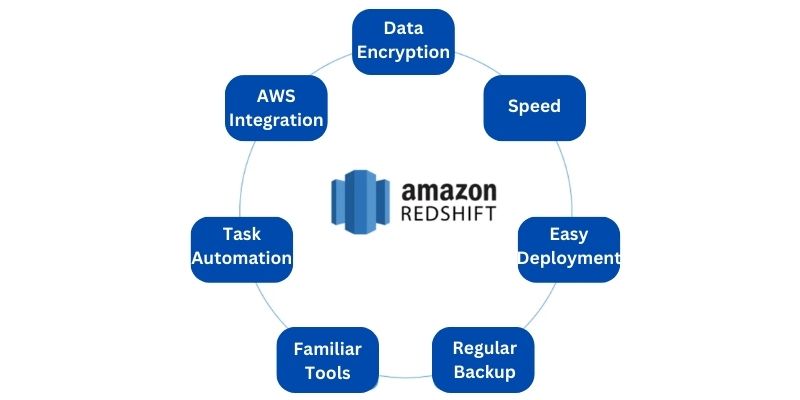
AWS Integration
Redshift seamlessly integrates with Amazon Web Services, one of the leading cloud solutions alongside Azure and Google Cloud. This integration allows for a smooth collaboration with other AWS services, enabling students to leverage the full potential of the cloud ecosystem.
Data Encryption and Security
Amazon prioritizes data security and offers multiple layers of protection. Clients have control over access control measures, virtual private clouds, and the option to encrypt their data. This flexibility ensures that students can implement robust security practices and protect sensitive information as required.
Speed
Redshift’s exceptional speed sets it apart. Leveraging its massively parallel processing (MPP) technology, Redshift delivers lightning-fast data processing and query execution. This means students can analyze vast datasets and obtain results quickly, enabling efficient data-driven decision-making.
Easy Deployment
Setting up a Redshift cluster is quick and cost-effective compared to traditional data warehouses. In just a few minutes, students can have a fully functional Redshift cluster up and running, saving valuable time and resources.
Regular Backup
Amazon takes care of regular and consistent backups, ensuring data availability for restoration and recovery operations. The backups are stored across multiple locations, enhancing data durability and protection.
Familiar Tools
Redshift utilizes PostgreSQL, a popular and widely used database technology. This compatibility enables students to leverage their existing SQL skills and work with familiar tools for data extraction, transformation, loading (ETL), and business intelligence (BI) tasks.
Repetitive Task Automation
Redshift offers the convenience of automating repetitive tasks. By automating routine operations, such as data ingestion or data transformation processes, students can save time and free up their staff to focus on more complex and critical responsibilities.
Enrol for Cloud Computing Training in Bangalore and learn different cloud computing services and how to provide them.
Limitations
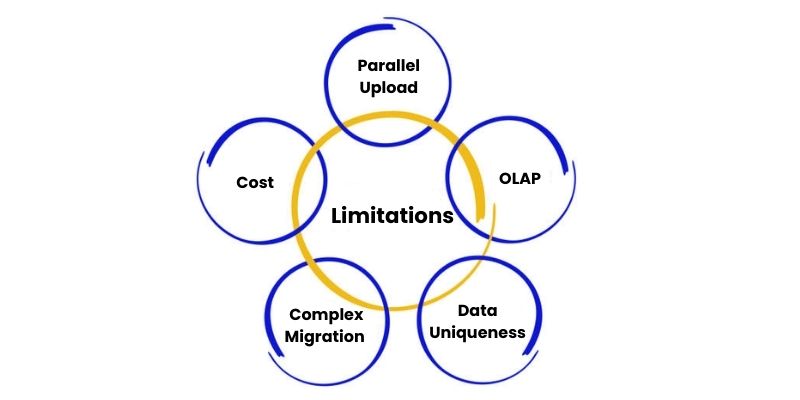
Potentially Complex Migration
When organizations have large volumes of data in the petabyte range, migrating that data to AWS Redshift can be a complex and potentially costly process. Bandwidth limitations and data transfer costs need to be carefully considered to ensure a smooth and cost-effective migration.
Parallel Upload Limitations
Redshift offers seamless parallel uploading for data from Amazon S3, DynamoDB, and EMR databases. However, when it comes to other data sources, students may need to develop separate scripts or processes for uploading data in parallel, which can introduce additional complexity.
Data Uniqueness Challenges
Redshift does not provide built-in tools or mechanisms to enforce data uniqueness. This means that students may need to implement their own strategies or processes to ensure the avoidance of duplicate data points, which is crucial for accurate analysis and reporting.
OLAP Limitations
Redshift is primarily designed as an OLAP database optimized for analytical queries on large datasets. However, when it comes to basic database operations such as insert, update, and delete, it may not perform as efficiently as traditional OLTP databases. Students should be aware of these limitations and understand the trade-offs between OLAP and OLTP databases for different use cases.
Cost Considerations
While Redshift offers cost savings compared to traditional on-premises data warehousing, it’s essential to understand the factors that influence its pricing. The following elements should be considered when estimating the cost of using Redshift
Compute Node Types
Redshift offers different node types optimized for various workloads, ranging from dense storage nodes to dense compute nodes. The cost varies based on the chosen node type and its associated CPU, memory, and storage capacity.
Data Storage
Redshift charges for the amount of data stored in the cluster. Redshift’s columnar compression reduces storage costs, but it’s crucial to consider the size of your dataset and its growth rate.
Data Transfer
Redshift imposes charges for data transferred into and out of the cluster. It’s important to estimate the frequency and volume of data transfers, particularly if you’re moving large datasets from external sources.
Backup and Snapshots
Redshift provides automated backups and snapshots to ensure data durability. However, these features incur additional costs based on the frequency and size of backups.
Amazon Redshift: How Do I Set It Up?
Here’s a step-by-step guide to setting up AWS Redshift
Setting up Amazon Redshift is a straightforward process that involves the following steps:
Create an AWS account

If you don’t have one already, sign up for an Amazon Web Services account.
Configure Firewall Settings

Ensure that the required port (typically 5439) is open in your firewall to allow Redshift access. Alternatively, you can specify a different open port during cluster creation, but note that it cannot be changed later.
Grant permissions for AWS resource access

Grant Redshift the necessary permissions to access other AWS resources. This can be done by creating a dedicated IAM role linked to the Redshift cluster or giving an IAM user with the required rights the AWS access key.
Launch a Redshift cluster
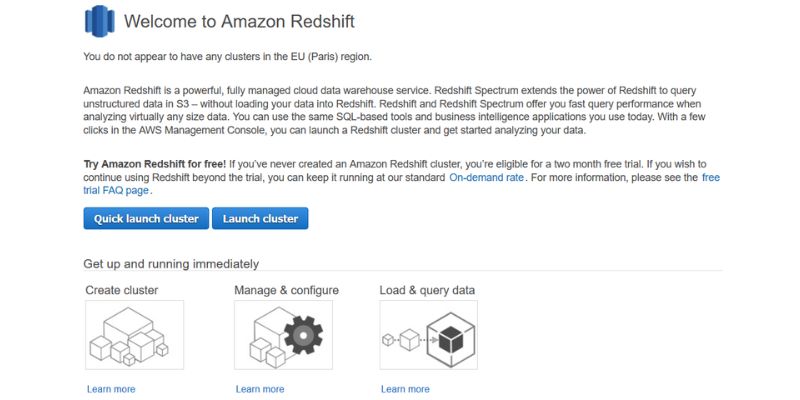
Log in with the authorised user account and access the Amazon Redshift console.
Select the area
Choose the area where you want to build your cluster.
Enter the required details
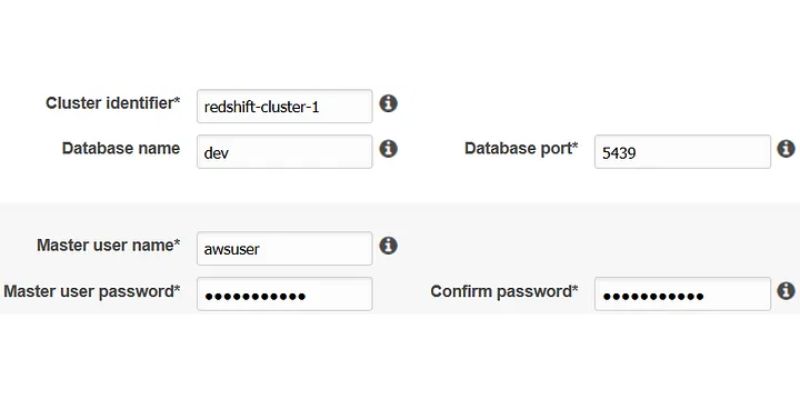
Opt for the Quick Launch Cluster option and provide the following values:
- Node type: dc2.large.
- Number of compute nodes: 2.
- Cluster identifier: example cluster.
- Master user name: AWS user.
- Master user password and Confirm password: Set a password for the master user account.
- Database port: 5439.
- Available IAM roles: Select myRedshiftRole.
Wait for the launch
Click on Launch Cluster and allow a few minutes for the cluster to be created. Once finished, click Close to return to the cluster list.
Configure cluster settings
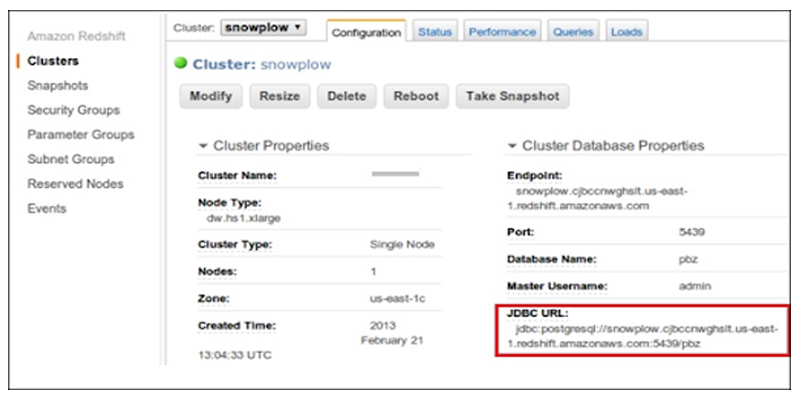
Select the desired cluster, click on the Cluster button, and choose Modify. Here, you can associate the cluster with the appropriate VPC security groups. Save your selection by clicking Modify.
Authorize access
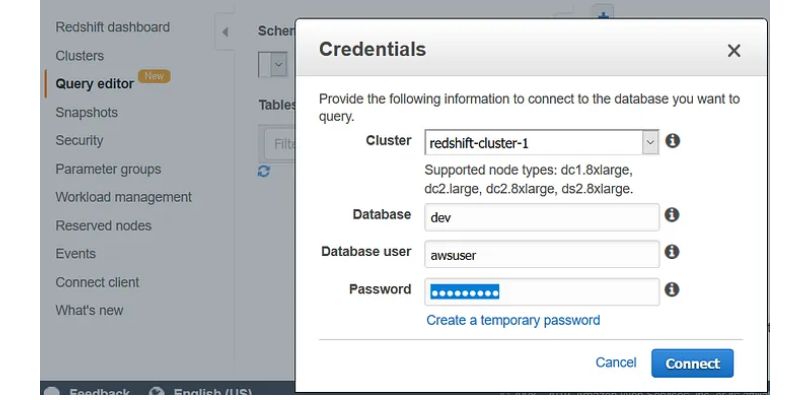
Configure a security group to authorise access. For clusters from an EC2-VPC platform, follow the specific steps provided.
Design and execute
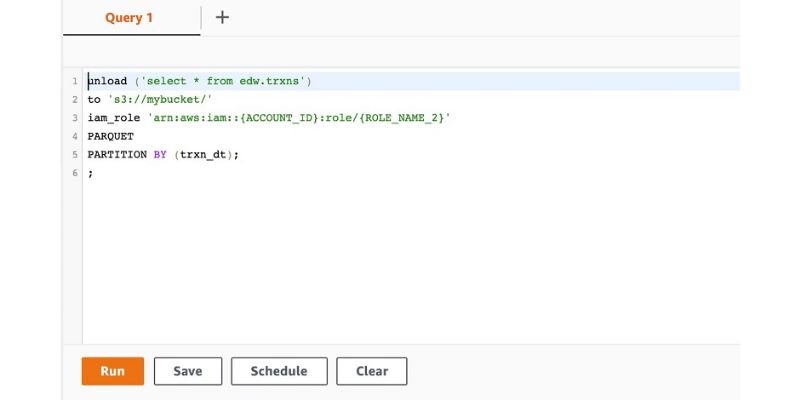
Design and execute Analytical queries to extract insights from your data. From this point forward, you can perform various tasks, such as running queries on your Redshift cluster. For more comprehensive instructions, it is recommended to refer to the AWS website.
Learn Google Cloud Training in Chennai from FITA Academy and understand about different network models and services.
How Would You Like to Become a Solutions Architect?
In today’s technology-driven world, the demand for cloud-related professionals is on the rise, offering enticing benefits such as job security, challenging opportunities, and attractive rewards. If you aspire to pursue a career in this dynamic field, Simplilearn provides a comprehensive solution with its Cloud Architect Master’s program, designed to equip you with the necessary expertise to excel as a solutions architect.
The Cloud Architect Master’s program focuses on cloud applications and architecture, enabling you to develop mastery in the core skill sets essential for building and deploying highly scalable, fault-tolerant, and reliable applications. This program encompasses the three leading Amazon Web Services, Microsoft Azure, and Google Cloud Platform are three cloud platform providers. By gaining proficiency across these platforms, you can confidently navigate the diverse cloud landscape and meet a variety of people’s demands organizations.
When it comes to the rewards of a career as a solutions architect, the numbers speak for themselves.Solutions architects in the US, according to Glassdoor earn an impressive annual average salary of USD 137,265, highlighting the financial stability and potential for growth in this field. In India, Payscale reports that solutions architects earn a yearly average of ₹1,811,766, showcasing the attractive remuneration opportunities available in the Indian market.
amazon redshift database offers a scalable, cost-effective, and high-performance solution for data warehousing and analytics in the cloud. Its benefits include scalability, performance, easy integration, cost-effectiveness, and robust security. By understanding the cost considerations and following the setup guide, organizations can leverage AWS redshift data sharing is to process and analyze large volumes of data efficiently, leading to valuable insights and informed decision-making.


